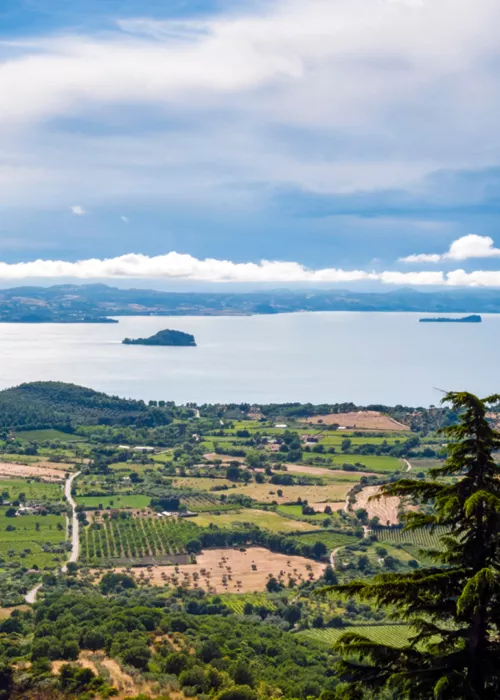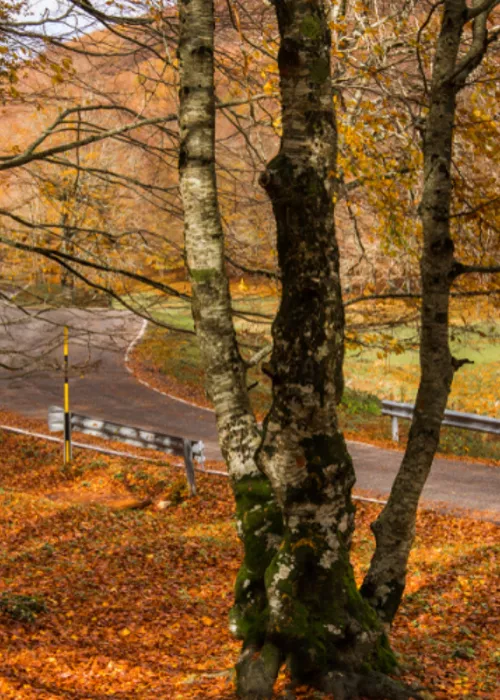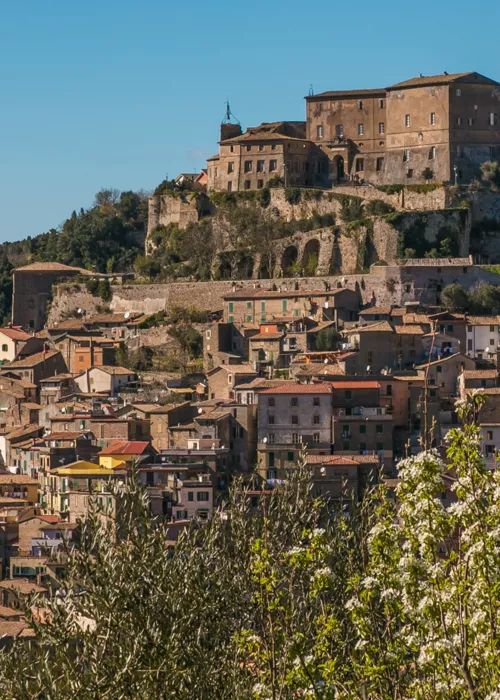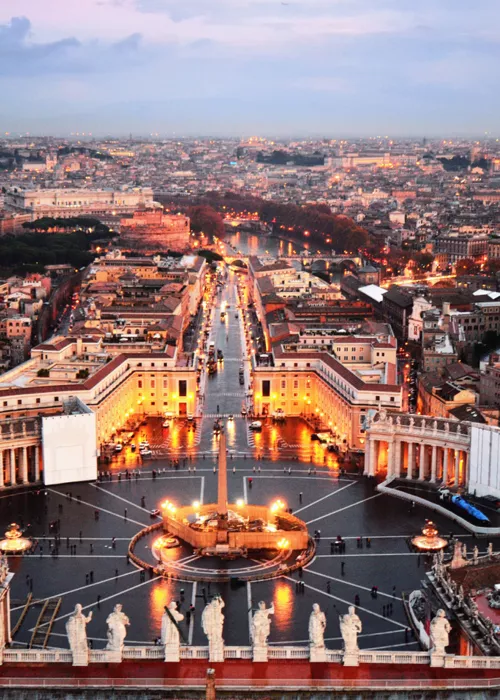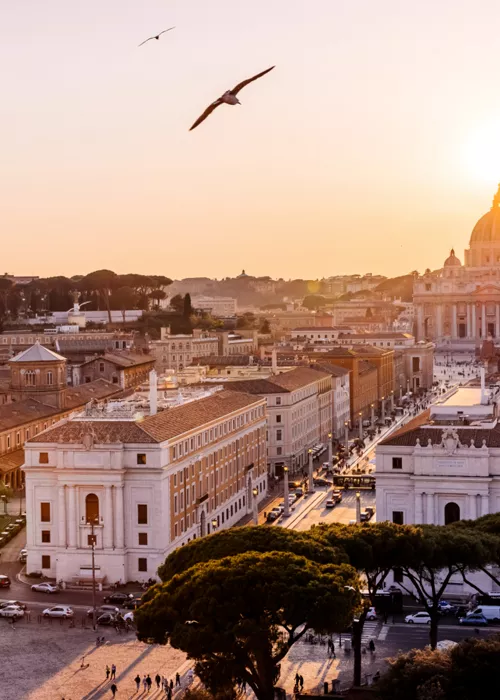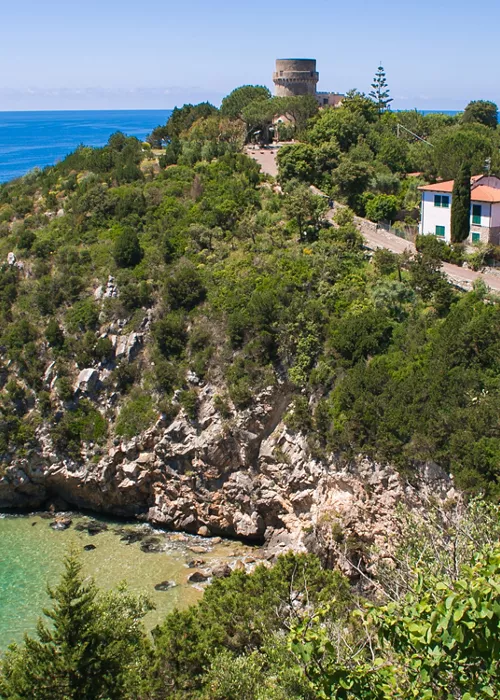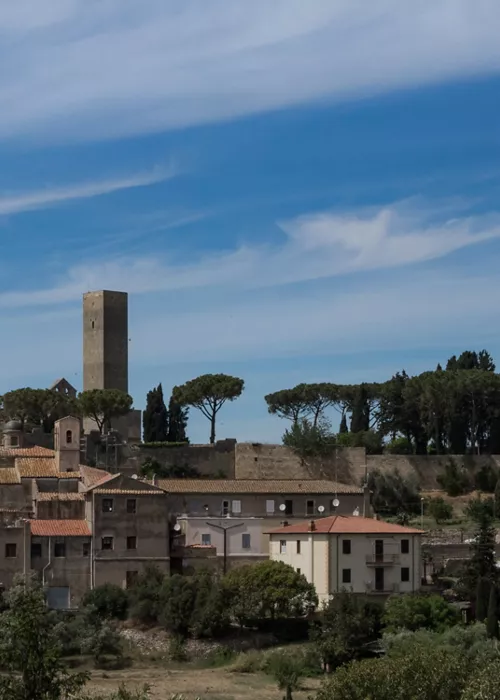St. Peter's Square

In St Peter's Square you are standing in the heart of the Vatican as well as in the most famous square in the world. It is a masterpiece of visually striking architecture: 4 rows of columns form theimposing space that welcomes the faithful. The enveloping effect was desired by Bernini himself who, when designing the square, wanted the colonnade to depict the maternal arms of the Church.
The dimensions are simply monumental: at its widest point, the square measures 320 by 240 metres, while the colonnade consists of 284 columns surmounted by 140 statues of saints. In the centre, flanked by two 17th-century fountains, stands theVatican Obelisk. It is 25 metres high and comes from Heliopolis, a city in ancient Egypt. At the end of the right-hand colonnade is a bronze door that gives access to the Vatican. Above it is the facade of the Apostolic or Vatican Palace, which has been the residence of the popes for over six centuries. The window on the top floor, the second from the right, is the pontiff's study: it is from here that the pope addresses the faithful. The Vatican Palace is part of a larger complex, where you will also find theVatican Museums, with their enchanting gardens.
Basilica of St. Peter

All the wonderful churches in Rome cannot compare with this one. St Peter's Basilica is the most important and magnificent due to its grandeur, opulence and harmony. It is also the ultimate symbol of Catholicism. A monument created by centuries of artistic genius, inside it features masterpieces such as the Pietà, a statue sculpted in 1498-99 by Michelangelo, at the age of 23. Centuries later, it still captivates the onlooker with its perfection, masterful technique and emotional impact. Other spectacular treasures include Michelangelo's dome and Bernini's Baldachin, a towering bronze canopy that blends harmoniously into the grandiose space decorated by Michelangelo, in the centre of the basilica above the high altar, supported by four gigantic helical columns. As you enter the basilica, the altar, with the light filtering down from above through the dome and from the window framed by a crown of golden angels, is a heavenly vision.
From the left-hand nave, you can access the Treasury Museum of St Peter's , which houses sacred relics and artistic treasures, while the central nave leads to the Vatican Grottoes and some papal tombs.
For a true understanding of the extraordinary size of the basilica, the numbers say it all. The church has a floor area of 22,067 square metres, and is 186 metres long (219 if you count the portico). The walls are about 115 metres wide on the facade, and 136 metres in height, up to the top of the dome, which has an internal diameter of 42 metres.
Outside, the broadflight of steps designed by Bernini, flanked by the large 19th-century statues of St Peter on the left, and St Paul on the right, precede the immense façade created by Carlo Maderno between 1607 and 1614, spanned by 8 columns and surmounted by 13 statues depicting the Redeemer, St John the Baptist and 11 apostles. The central balcony is the Loggia of the Blessings, from which the pope gives solemn blessings
In the lower part is the portico, with two arches at the ends. The one on the left leads to the Vatican City. Five bronze doors give access to the basilica, with the last one on the right being the Holy Door , which is opened only in the Jubilee year.
The entire structure is crowned by the giant dome, which Michelangelo did not live to see completed, as he died in 1564.
Dome

Its total weight is approximately 14,000 tonnes, with an external height to the top of the cross of 133 metres and an internal height of 117 metres, from the floor to the vault of the lantern. The external diameter is 59 metres, the internal diameter 42 metres and it has a surface area of 3,000 square metres. These are the impressive statistics of the dome, which is the work of the genius of Michelangelo.
Its construction began in 1546 but was interrupted in 1564 following the death of Michelangelo, who did not have the satisfaction of seeing it completed. The work was resumed in 1588 by Giacomo Della Porta and Domenico Fontana , who completed it in 1589, amid fireworks and a special mass.
Bathed in light, which also creates a stunning visual impact on the inside, the dome rises to 119 metres above Bernini's baldachin. Inspired by the the one designed by Brunelleschi for the cathedral in Florence, the dome is supported by four massive pillars, named after the four saints, whose statues reside in alcoves also designed by Bernini. To these saints belong the four relics preserved in the basilica: the lance used by the soldier Longinus to pierce the side of Christ, the veil of Veronica used to wipe the face of Jesus, a fragment of the cross found by St Helena in Jerusalem, and the skull of St Andrew.
The entire canopy is covered with wonderful blue and gold mosaics, on six levels, created by Giuseppe Cesari (known as the Cavalier d'Arpino) in 1605.
You can reach the top of dome either with the lift or up a flight of over 500 steps. It is accessed from the entrance on the right-hand side of the portico, by climbing the long and arduous spiral staircase, nicknamed "St Andrew's Snail". The effort is amply rewarded on reaching the top, at a height of about 120 metres, where there is a spectacular view over the square and the colonnade. If you turn your gaze 360°, you can see the whole of the city of Rome, as far as the Castelli Romani and the sea.
An interesting fact: not far from the Gianicolo, in a charming little street called Via Niccolò Piccolomini, an unusual surprise awaits you, one of the many "magnificent deceptions" of Rome. Here you can see the optical illusion of the "Cupolone", as the Romans affectionately call it. As you walk along the street, you will find yourself facing the dome of St. Peter's: as if by magic, the closer you get, the further away the dome appears; on the contrary, as you move back, the dome appears larger and closer.
Holy Door

Of the five bronze doors that give access to the Basilica, the last one on the right is the Holy Door, set in a carved marble frame commissioned by Pope Gregory XIII. It was made in 1949 by Vico Consorti (1902–1979) and is composed of a sculptural cycle presenting the story of humanity in sixteen panels, from the dawn of time to the present day.
A Holy Door is a door of a basilica that is only opened on the occasion of the Jubilee.
The Holy Door of St. Peter's is the most famous of all and is the first to be opened. There are in fact other Holy Doors in Rome. The three major basilicas of Rome have one each (San Giovanni in Laterano, Saint Paul Outside The Walls and Saint Mary Major) and the pope can decide to designate holy doors in any church in the world.
Until 1975, the door in St. Peter's was walled up at the end of each Jubilee and uncovered at the beginning of the next one. The pope who had proclaimed the Jubilee gave the first three hammer blows to the wall, which was then knocked down by bricklayers. Since the Jubilee of 2000, however, Pope John Paul II decided to change the ritual. Nowadays, the wall sealing the Holy Door of St. Peter's is dismantled in the days leading up to the opening, a box containing the key the door is taken out, and the pope symbolically pushes the door open. Thus, the Jubilee officially begins and from that moment on, the door remains open throughout the year for the passage of pilgrims. The Holy Door in fact has a very precise meaning: it is the symbol of the transition that every believer must make from sin to grace, thinking of Jesus who says "I am the gate".
The Holy Year ends with its closure.









